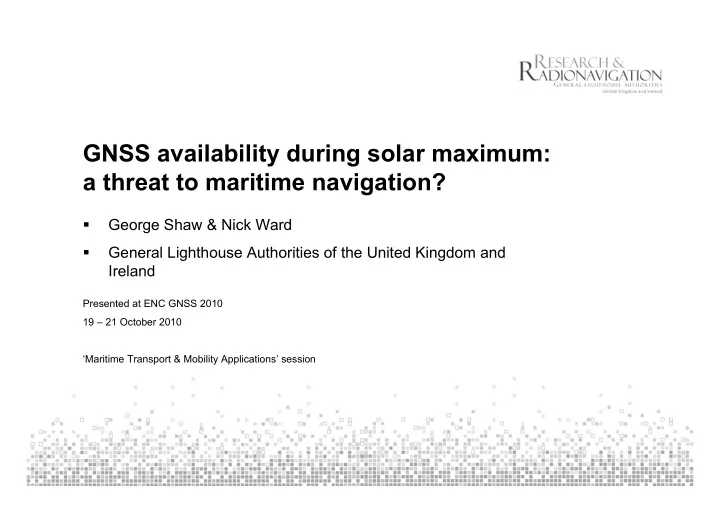

GNSS availability during solar maximum: a threat to maritime navigation? � George Shaw & Nick Ward � General Lighthouse Authorities of the United Kingdom and Ireland Presented at ENC GNSS 2010 19 – 21 October 2010 ‘Maritime Transport & Mobility Applications’ session
Contents � Reliance of shipping on GPS � Impact of ionospheric effects on GNSS � Impact of reduced GPS constellation � Multi-constellation benefits of Galileo � A threat to maritime navigation? � Conclusion
Ships rely heavily on GPS � GNSS is essential for efficiency and safety of shipping � GPS is at the heart of today’s integrated bridges - Drives chart displays . - Controls the autopilot - Stabilises radar display and gyro-compass � GPS provides ship position for AIS and VTS � GPS provides coordinates for emergency rescue Source: Trinity House
DGPS is a primary Aid to Navigation GLA DGPS Reference Stations
Ionosphere effects GNSS propagation Ionospheric scintillation and delay, courtesy University of Bath Temporal and spatial gradients in the Total Electron Content (TEC)
GNSS is at risk during Solar Maximum � GNSS signal refraction & diffraction � Phase scintillation - significant delay in pseudorange measurement � Amplitude scintillation - strong fades may lead GNSS receiver losing signal tracking � Standalone range errors up to 60m Polar scintillation, courtesy University of Bath � Loss of navigation solution
Solar Maximum is predicted in 2013 � SWPC predicts 11 year cycle solar maximum in May 2013 � Increase in solar storms & flares � ‘Superstorms’ possible - ‘Carrington Event’ of 1859 � Highest levels of scintillation occur in bands of latitude: - equatorial (±10º), - auroral regions (65º - 75º) - polar cap (>75º)
Coincides with possible reduced GPS � US GAO prediction - Probability of maintaining full GPS constellation falls to typically 85% over 2011-13 � GLA / GRACE study - simulation of 21 GPS satellites - 2 representative marine GPS receivers (hardware-in-the-loop) - analysis of impact on DGPS AtoN & ships’ navigation aids
Results in GPS outages and errors � GPS coverage ‘windows’ found - only 3 satellites in view � horizontal position errors typically increased by 50% � occasional error spikes of the order of many tens of metres � GPS outages last up to 10 minutes � up to 10km error build up for a fast vessel travelling at 35 knots
Very limited help from Galileo in 2013 � Multi-constellation (and GPS modernisation) - measures to improve GNSS resilience - increased number of satellites - greater frequency diversity � Galileo - only 4 initial satellites (IOV phase) by 2011 - IOC (18 SVs) and FOC (30 SVs) help eventually (2018) � GLONASS - only the newest (GLONASS K) satellites are expected to provide a CDMA signal compatible with GPS and Galileo - full complement not available in the timescale
A threat to maritime navigation? � Beacon DGPS should be resilient and continue to provide integrity - invalidates GPS satellites not in view (by not transmitting corrections) - monitors integrity and provides corrections for visible satellites � Increased position errors of standalone GPS - may go unnoticed by the mariner . - impairs the mariner’s situational awareness � Ships’ navigation systems may alarm when GPS indicates ‘no position solution’ - impairs the mariner’s situational awareness - forces reversion to fallback navigation techniques � visual references, chart and compass - limited training and familiarity with fallbacks Credit: Tim Stevens
Conclusion � Reduced availability of GNSS during solar maximum with possible reduced GPS poses a distinct threat to maritime navigation � Mitigation of future solar maxima - Galileo fully operational - Internal mitigation of ionosphere effects within the GNSS receiver - using space weather models to issue timely Notices to Mariners
Recommend
More recommend